Analysis of Accounting Exam 1 Homework Solution for Finance
VerifiedAdded on 2022/08/25
|18
|3413
|40
Homework Assignment
AI Summary
This document presents a complete solution to an Accounting Exam 1, designed for a finance course. The solution is divided into two parts: Part 1 includes answers to multiple-choice questions covering fundamental accounting concepts such as the accounting equation, financial statements (balance sheet, income statement, statement of cash flows), and the accounting cycle. Part 2 provides detailed problem-solving examples, including the analysis of transactions and their impact on financial statements, the creation of T-accounts, and the preparation of a trial balance, income statement, and balance sheet. The solutions cover the effects of various transactions on the financial statements, and the application of accounting principles. The document is a valuable resource for students seeking to understand and master the concepts covered in the exam.
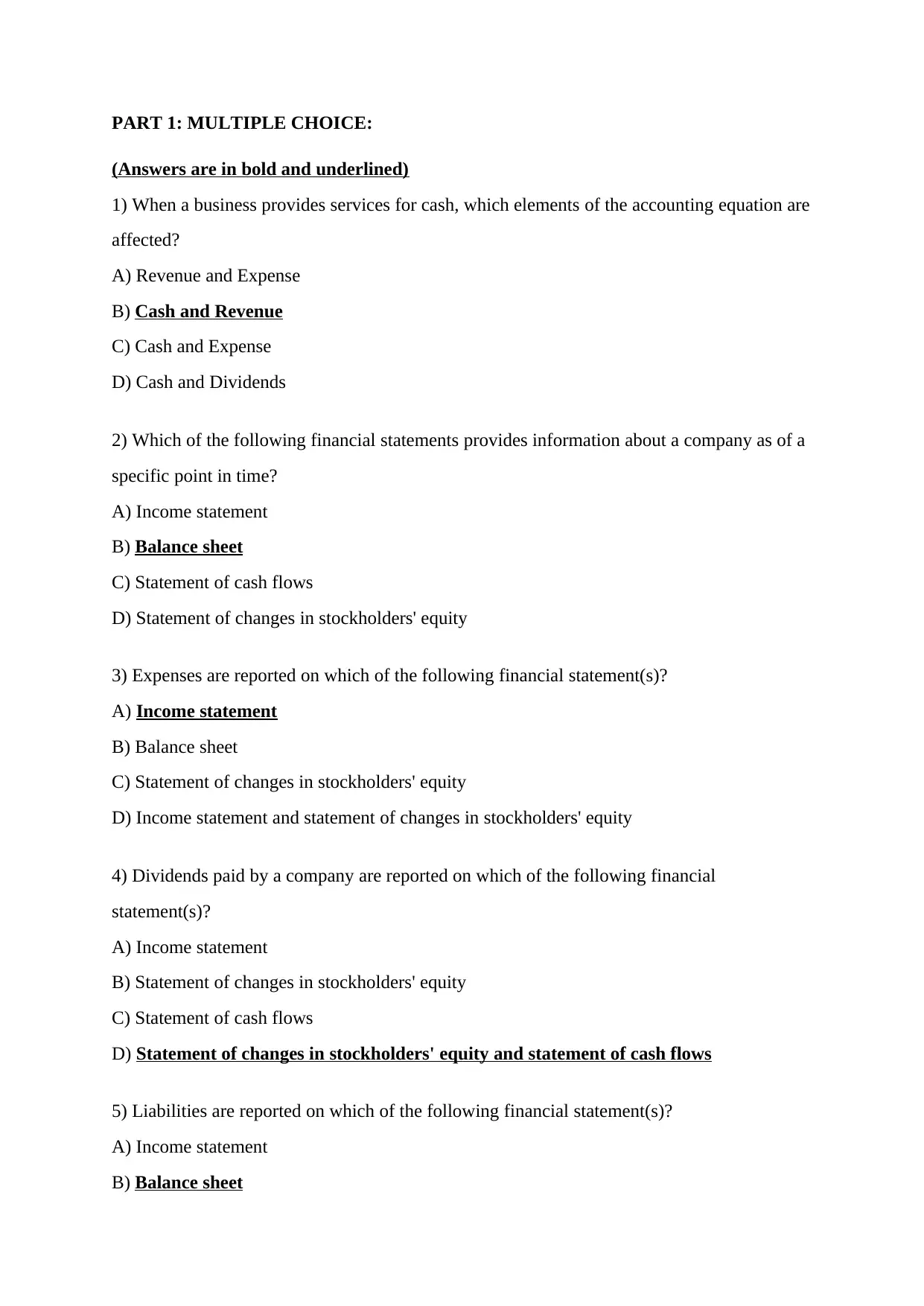
PART 1: MULTIPLE CHOICE:
(Answers are in bold and underlined)
1) When a business provides services for cash, which elements of the accounting equation are
affected?
A) Revenue and Expense
B) Cash and Revenue
C) Cash and Expense
D) Cash and Dividends
2) Which of the following financial statements provides information about a company as of a
specific point in time?
A) Income statement
B) Balance sheet
C) Statement of cash flows
D) Statement of changes in stockholders' equity
3) Expenses are reported on which of the following financial statement(s)?
A) Income statement
B) Balance sheet
C) Statement of changes in stockholders' equity
D) Income statement and statement of changes in stockholders' equity
4) Dividends paid by a company are reported on which of the following financial
statement(s)?
A) Income statement
B) Statement of changes in stockholders' equity
C) Statement of cash flows
D) Statement of changes in stockholders' equity and statement of cash flows
5) Liabilities are reported on which of the following financial statement(s)?
A) Income statement
B) Balance sheet
(Answers are in bold and underlined)
1) When a business provides services for cash, which elements of the accounting equation are
affected?
A) Revenue and Expense
B) Cash and Revenue
C) Cash and Expense
D) Cash and Dividends
2) Which of the following financial statements provides information about a company as of a
specific point in time?
A) Income statement
B) Balance sheet
C) Statement of cash flows
D) Statement of changes in stockholders' equity
3) Expenses are reported on which of the following financial statement(s)?
A) Income statement
B) Balance sheet
C) Statement of changes in stockholders' equity
D) Income statement and statement of changes in stockholders' equity
4) Dividends paid by a company are reported on which of the following financial
statement(s)?
A) Income statement
B) Statement of changes in stockholders' equity
C) Statement of cash flows
D) Statement of changes in stockholders' equity and statement of cash flows
5) Liabilities are reported on which of the following financial statement(s)?
A) Income statement
B) Balance sheet
Paraphrase This Document
Need a fresh take? Get an instant paraphrase of this document with our AI Paraphraser
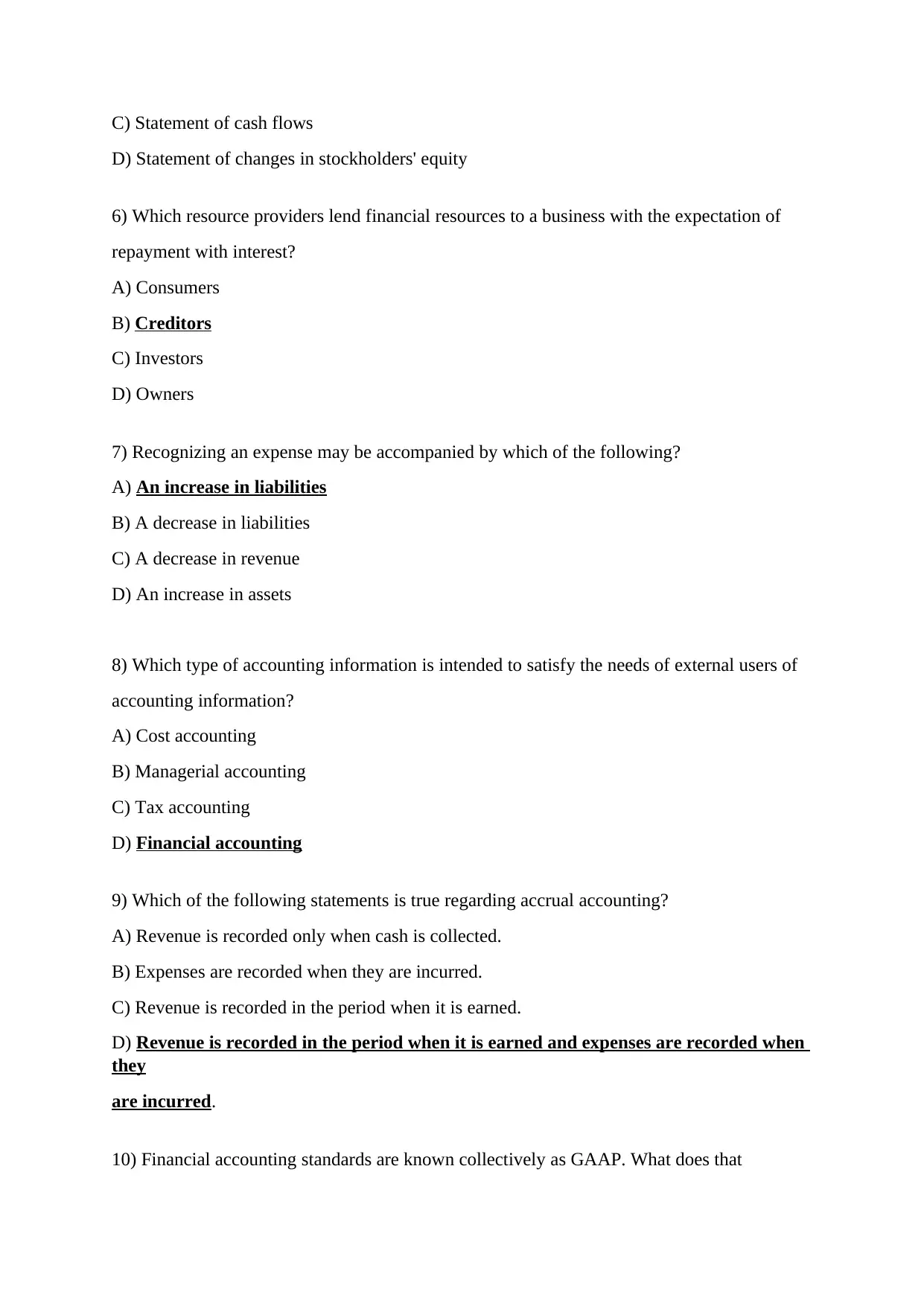
C) Statement of cash flows
D) Statement of changes in stockholders' equity
6) Which resource providers lend financial resources to a business with the expectation of
repayment with interest?
A) Consumers
B) Creditors
C) Investors
D) Owners
7) Recognizing an expense may be accompanied by which of the following?
A) An increase in liabilities
B) A decrease in liabilities
C) A decrease in revenue
D) An increase in assets
8) Which type of accounting information is intended to satisfy the needs of external users of
accounting information?
A) Cost accounting
B) Managerial accounting
C) Tax accounting
D) Financial accounting
9) Which of the following statements is true regarding accrual accounting?
A) Revenue is recorded only when cash is collected.
B) Expenses are recorded when they are incurred.
C) Revenue is recorded in the period when it is earned.
D) Revenue is recorded in the period when it is earned and expenses are recorded when
they
are incurred.
10) Financial accounting standards are known collectively as GAAP. What does that
D) Statement of changes in stockholders' equity
6) Which resource providers lend financial resources to a business with the expectation of
repayment with interest?
A) Consumers
B) Creditors
C) Investors
D) Owners
7) Recognizing an expense may be accompanied by which of the following?
A) An increase in liabilities
B) A decrease in liabilities
C) A decrease in revenue
D) An increase in assets
8) Which type of accounting information is intended to satisfy the needs of external users of
accounting information?
A) Cost accounting
B) Managerial accounting
C) Tax accounting
D) Financial accounting
9) Which of the following statements is true regarding accrual accounting?
A) Revenue is recorded only when cash is collected.
B) Expenses are recorded when they are incurred.
C) Revenue is recorded in the period when it is earned.
D) Revenue is recorded in the period when it is earned and expenses are recorded when
they
are incurred.
10) Financial accounting standards are known collectively as GAAP. What does that
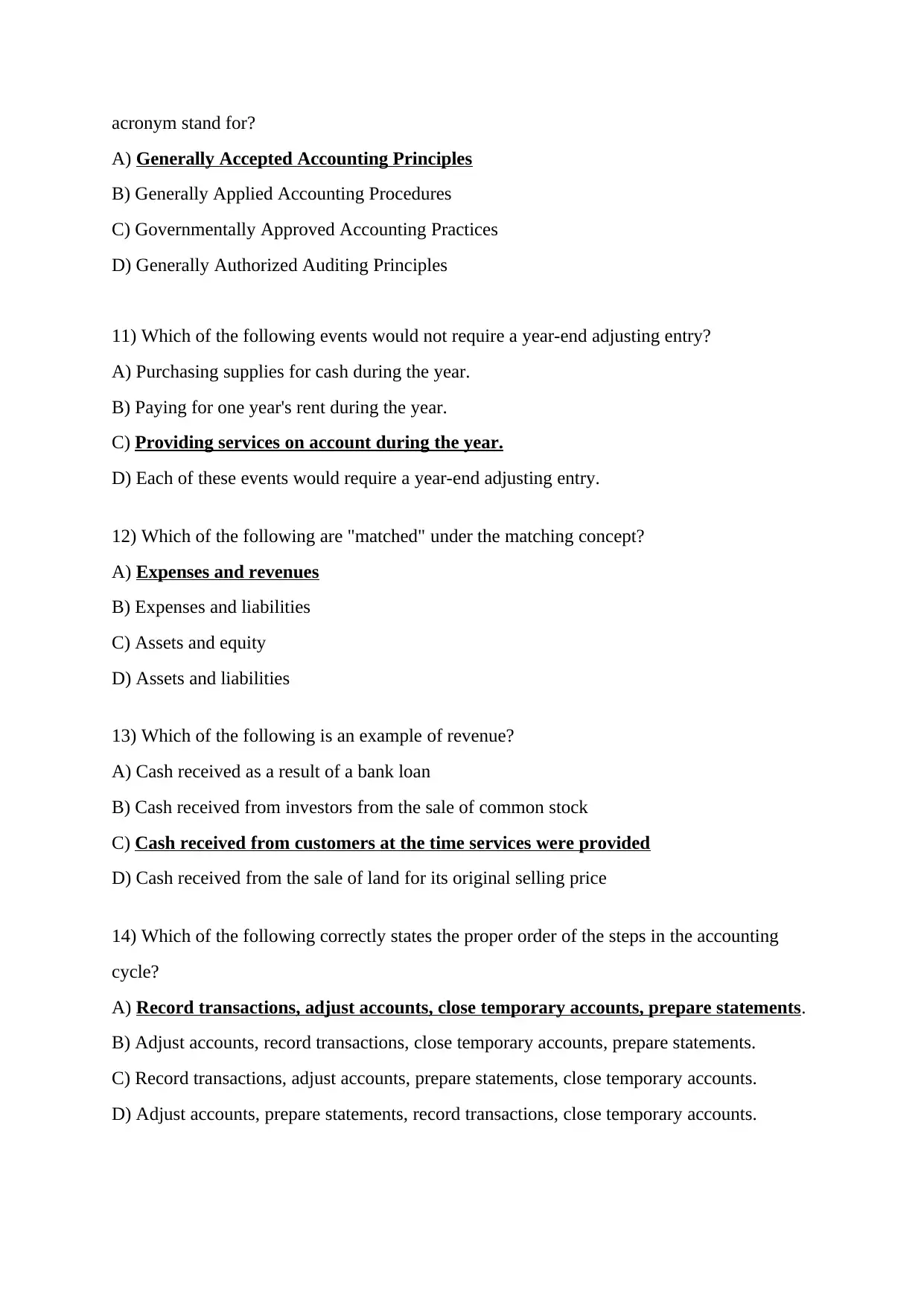
acronym stand for?
A) Generally Accepted Accounting Principles
B) Generally Applied Accounting Procedures
C) Governmentally Approved Accounting Practices
D) Generally Authorized Auditing Principles
11) Which of the following events would not require a year-end adjusting entry?
A) Purchasing supplies for cash during the year.
B) Paying for one year's rent during the year.
C) Providing services on account during the year.
D) Each of these events would require a year-end adjusting entry.
12) Which of the following are "matched" under the matching concept?
A) Expenses and revenues
B) Expenses and liabilities
C) Assets and equity
D) Assets and liabilities
13) Which of the following is an example of revenue?
A) Cash received as a result of a bank loan
B) Cash received from investors from the sale of common stock
C) Cash received from customers at the time services were provided
D) Cash received from the sale of land for its original selling price
14) Which of the following correctly states the proper order of the steps in the accounting
cycle?
A) Record transactions, adjust accounts, close temporary accounts, prepare statements.
B) Adjust accounts, record transactions, close temporary accounts, prepare statements.
C) Record transactions, adjust accounts, prepare statements, close temporary accounts.
D) Adjust accounts, prepare statements, record transactions, close temporary accounts.
A) Generally Accepted Accounting Principles
B) Generally Applied Accounting Procedures
C) Governmentally Approved Accounting Practices
D) Generally Authorized Auditing Principles
11) Which of the following events would not require a year-end adjusting entry?
A) Purchasing supplies for cash during the year.
B) Paying for one year's rent during the year.
C) Providing services on account during the year.
D) Each of these events would require a year-end adjusting entry.
12) Which of the following are "matched" under the matching concept?
A) Expenses and revenues
B) Expenses and liabilities
C) Assets and equity
D) Assets and liabilities
13) Which of the following is an example of revenue?
A) Cash received as a result of a bank loan
B) Cash received from investors from the sale of common stock
C) Cash received from customers at the time services were provided
D) Cash received from the sale of land for its original selling price
14) Which of the following correctly states the proper order of the steps in the accounting
cycle?
A) Record transactions, adjust accounts, close temporary accounts, prepare statements.
B) Adjust accounts, record transactions, close temporary accounts, prepare statements.
C) Record transactions, adjust accounts, prepare statements, close temporary accounts.
D) Adjust accounts, prepare statements, record transactions, close temporary accounts.
⊘ This is a preview!⊘
Do you want full access?
Subscribe today to unlock all pages.

Trusted by 1+ million students worldwide
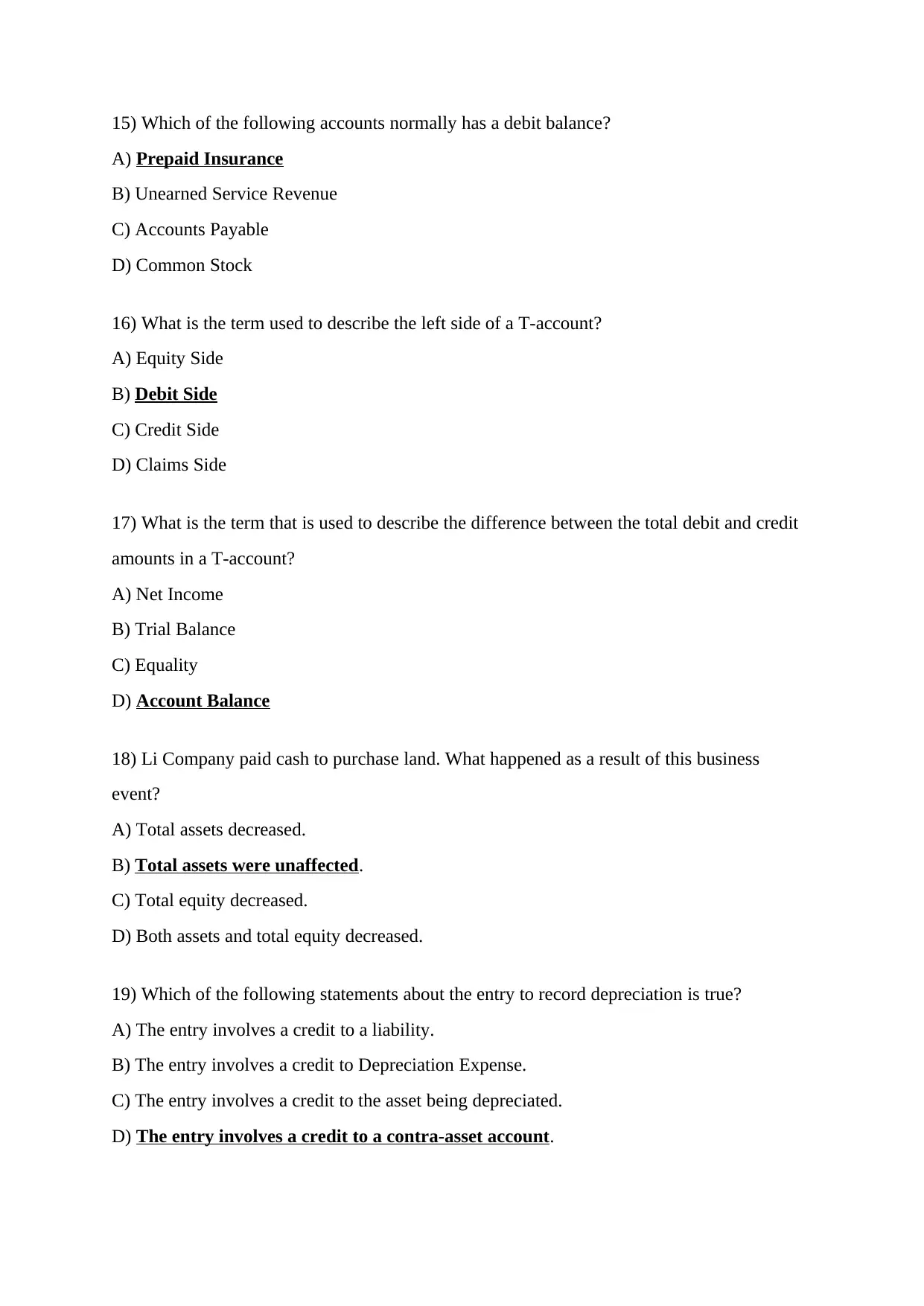
15) Which of the following accounts normally has a debit balance?
A) Prepaid Insurance
B) Unearned Service Revenue
C) Accounts Payable
D) Common Stock
16) What is the term used to describe the left side of a T-account?
A) Equity Side
B) Debit Side
C) Credit Side
D) Claims Side
17) What is the term that is used to describe the difference between the total debit and credit
amounts in a T-account?
A) Net Income
B) Trial Balance
C) Equality
D) Account Balance
18) Li Company paid cash to purchase land. What happened as a result of this business
event?
A) Total assets decreased.
B) Total assets were unaffected.
C) Total equity decreased.
D) Both assets and total equity decreased.
19) Which of the following statements about the entry to record depreciation is true?
A) The entry involves a credit to a liability.
B) The entry involves a credit to Depreciation Expense.
C) The entry involves a credit to the asset being depreciated.
D) The entry involves a credit to a contra-asset account.
A) Prepaid Insurance
B) Unearned Service Revenue
C) Accounts Payable
D) Common Stock
16) What is the term used to describe the left side of a T-account?
A) Equity Side
B) Debit Side
C) Credit Side
D) Claims Side
17) What is the term that is used to describe the difference between the total debit and credit
amounts in a T-account?
A) Net Income
B) Trial Balance
C) Equality
D) Account Balance
18) Li Company paid cash to purchase land. What happened as a result of this business
event?
A) Total assets decreased.
B) Total assets were unaffected.
C) Total equity decreased.
D) Both assets and total equity decreased.
19) Which of the following statements about the entry to record depreciation is true?
A) The entry involves a credit to a liability.
B) The entry involves a credit to Depreciation Expense.
C) The entry involves a credit to the asset being depreciated.
D) The entry involves a credit to a contra-asset account.
Paraphrase This Document
Need a fresh take? Get an instant paraphrase of this document with our AI Paraphraser
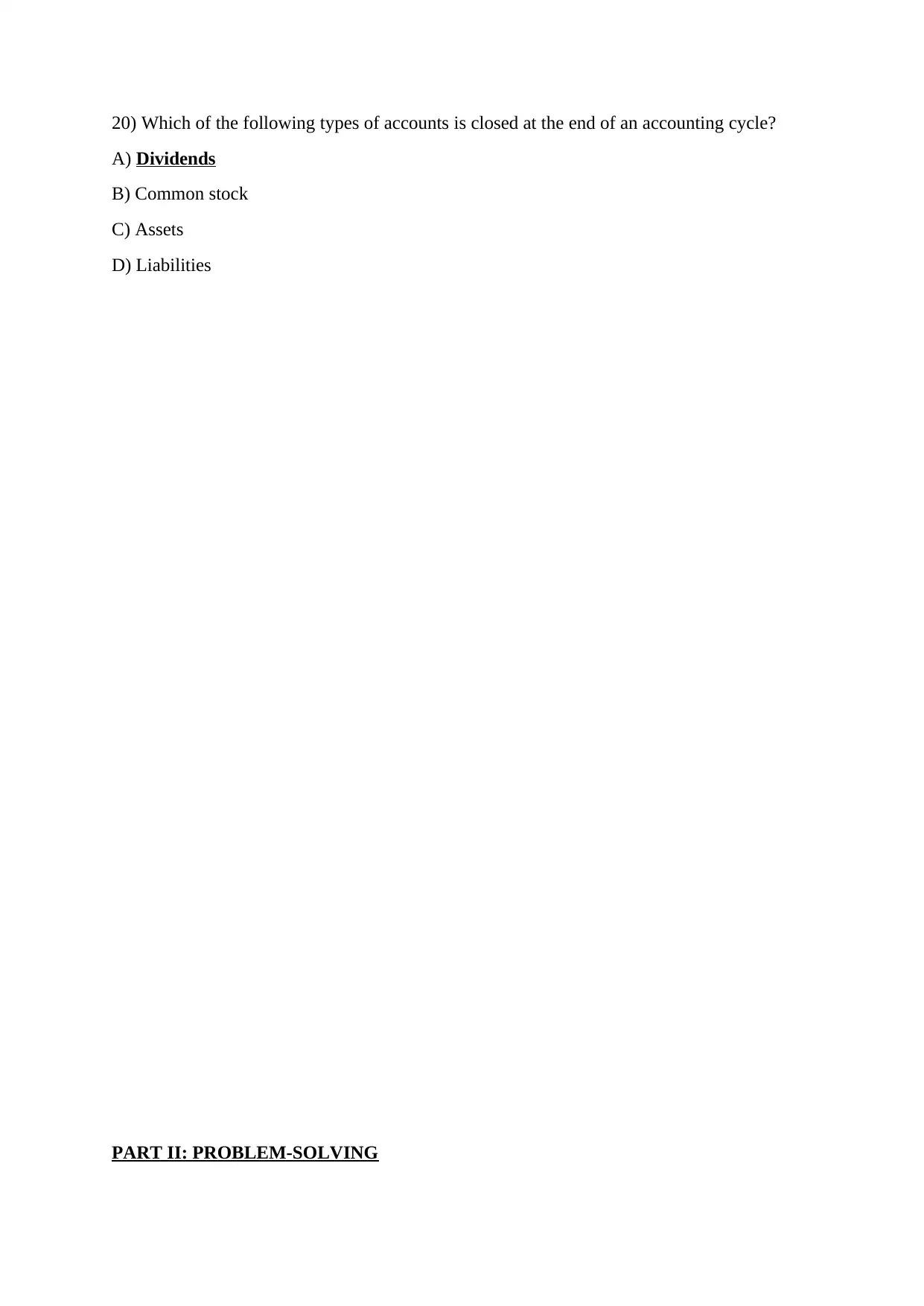
20) Which of the following types of accounts is closed at the end of an accounting cycle?
A) Dividends
B) Common stock
C) Assets
D) Liabilities
PART II: PROBLEM-SOLVING
A) Dividends
B) Common stock
C) Assets
D) Liabilities
PART II: PROBLEM-SOLVING
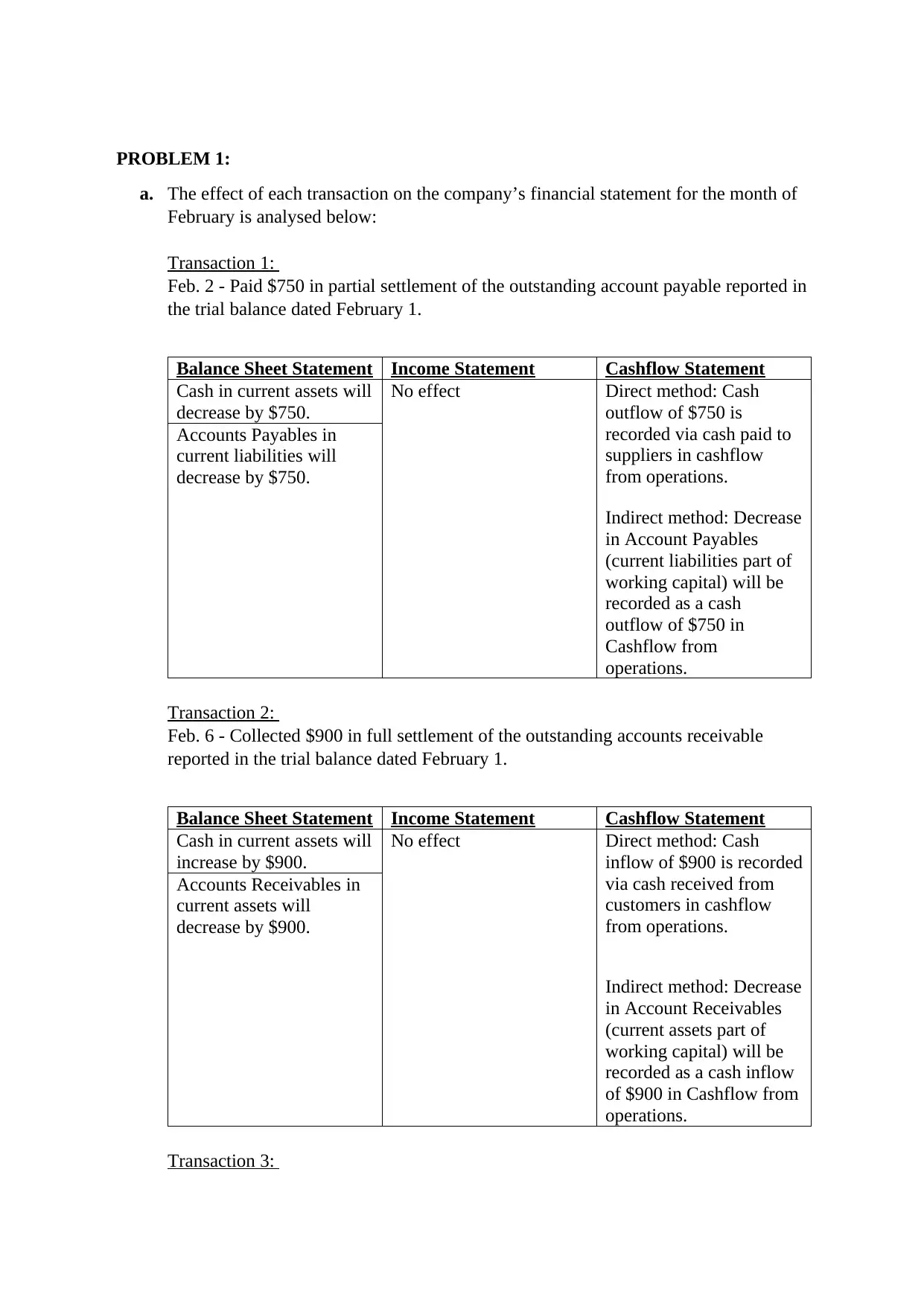
PROBLEM 1:
a. The effect of each transaction on the company’s financial statement for the month of
February is analysed below:
Transaction 1:
Feb. 2 - Paid $750 in partial settlement of the outstanding account payable reported in
the trial balance dated February 1.
Balance Sheet Statement Income Statement Cashflow Statement
Cash in current assets will
decrease by $750.
No effect Direct method: Cash
outflow of $750 is
recorded via cash paid to
suppliers in cashflow
from operations.
Indirect method: Decrease
in Account Payables
(current liabilities part of
working capital) will be
recorded as a cash
outflow of $750 in
Cashflow from
operations.
Accounts Payables in
current liabilities will
decrease by $750.
Transaction 2:
Feb. 6 - Collected $900 in full settlement of the outstanding accounts receivable
reported in the trial balance dated February 1.
Balance Sheet Statement Income Statement Cashflow Statement
Cash in current assets will
increase by $900.
No effect Direct method: Cash
inflow of $900 is recorded
via cash received from
customers in cashflow
from operations.
Indirect method: Decrease
in Account Receivables
(current assets part of
working capital) will be
recorded as a cash inflow
of $900 in Cashflow from
operations.
Accounts Receivables in
current assets will
decrease by $900.
Transaction 3:
a. The effect of each transaction on the company’s financial statement for the month of
February is analysed below:
Transaction 1:
Feb. 2 - Paid $750 in partial settlement of the outstanding account payable reported in
the trial balance dated February 1.
Balance Sheet Statement Income Statement Cashflow Statement
Cash in current assets will
decrease by $750.
No effect Direct method: Cash
outflow of $750 is
recorded via cash paid to
suppliers in cashflow
from operations.
Indirect method: Decrease
in Account Payables
(current liabilities part of
working capital) will be
recorded as a cash
outflow of $750 in
Cashflow from
operations.
Accounts Payables in
current liabilities will
decrease by $750.
Transaction 2:
Feb. 6 - Collected $900 in full settlement of the outstanding accounts receivable
reported in the trial balance dated February 1.
Balance Sheet Statement Income Statement Cashflow Statement
Cash in current assets will
increase by $900.
No effect Direct method: Cash
inflow of $900 is recorded
via cash received from
customers in cashflow
from operations.
Indirect method: Decrease
in Account Receivables
(current assets part of
working capital) will be
recorded as a cash inflow
of $900 in Cashflow from
operations.
Accounts Receivables in
current assets will
decrease by $900.
Transaction 3:
⊘ This is a preview!⊘
Do you want full access?
Subscribe today to unlock all pages.

Trusted by 1+ million students worldwide
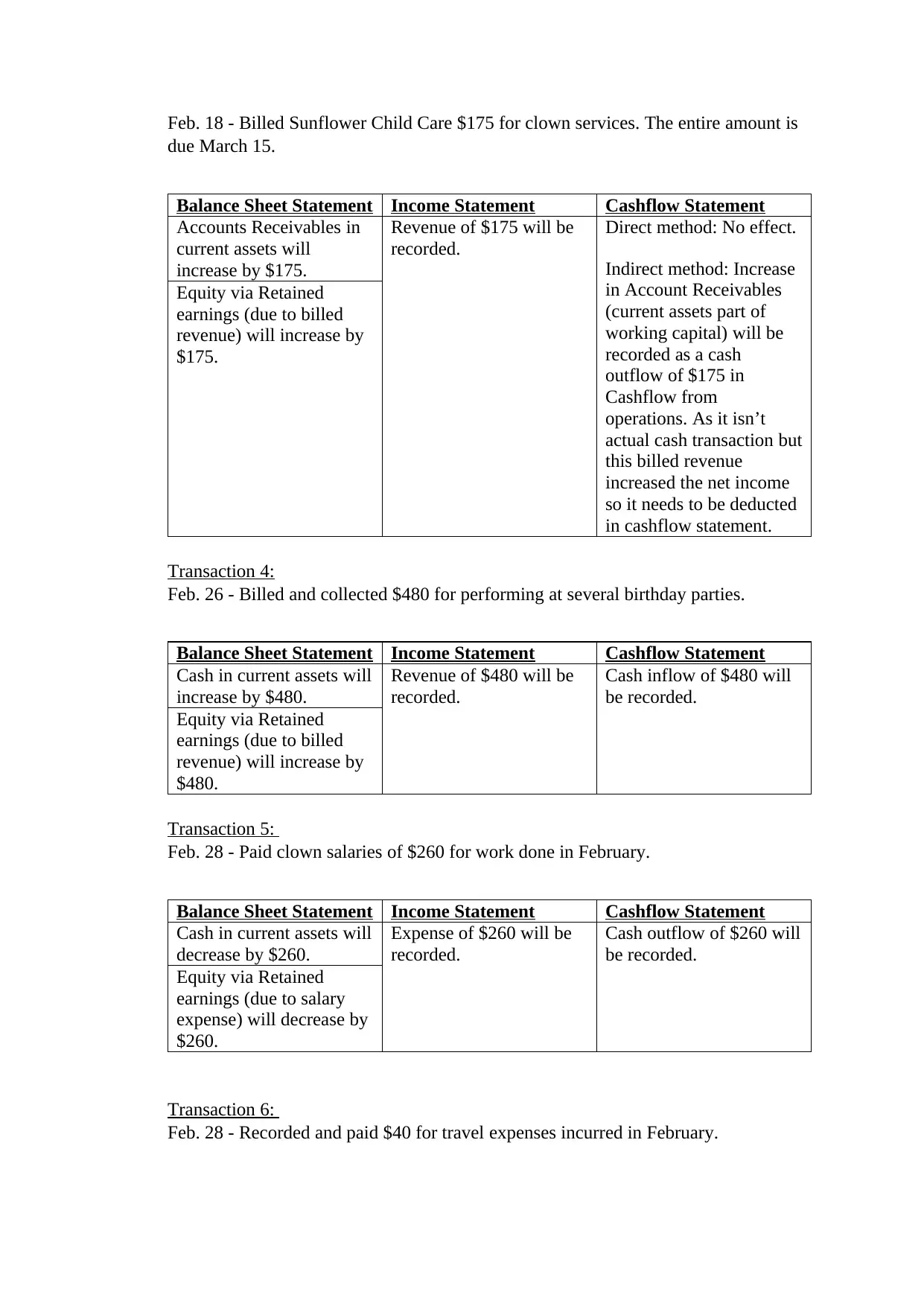
Feb. 18 - Billed Sunflower Child Care $175 for clown services. The entire amount is
due March 15.
Balance Sheet Statement Income Statement Cashflow Statement
Accounts Receivables in
current assets will
increase by $175.
Revenue of $175 will be
recorded.
Direct method: No effect.
Indirect method: Increase
in Account Receivables
(current assets part of
working capital) will be
recorded as a cash
outflow of $175 in
Cashflow from
operations. As it isn’t
actual cash transaction but
this billed revenue
increased the net income
so it needs to be deducted
in cashflow statement.
Equity via Retained
earnings (due to billed
revenue) will increase by
$175.
Transaction 4:
Feb. 26 - Billed and collected $480 for performing at several birthday parties.
Balance Sheet Statement Income Statement Cashflow Statement
Cash in current assets will
increase by $480.
Revenue of $480 will be
recorded.
Cash inflow of $480 will
be recorded.
Equity via Retained
earnings (due to billed
revenue) will increase by
$480.
Transaction 5:
Feb. 28 - Paid clown salaries of $260 for work done in February.
Balance Sheet Statement Income Statement Cashflow Statement
Cash in current assets will
decrease by $260.
Expense of $260 will be
recorded.
Cash outflow of $260 will
be recorded.
Equity via Retained
earnings (due to salary
expense) will decrease by
$260.
Transaction 6:
Feb. 28 - Recorded and paid $40 for travel expenses incurred in February.
due March 15.
Balance Sheet Statement Income Statement Cashflow Statement
Accounts Receivables in
current assets will
increase by $175.
Revenue of $175 will be
recorded.
Direct method: No effect.
Indirect method: Increase
in Account Receivables
(current assets part of
working capital) will be
recorded as a cash
outflow of $175 in
Cashflow from
operations. As it isn’t
actual cash transaction but
this billed revenue
increased the net income
so it needs to be deducted
in cashflow statement.
Equity via Retained
earnings (due to billed
revenue) will increase by
$175.
Transaction 4:
Feb. 26 - Billed and collected $480 for performing at several birthday parties.
Balance Sheet Statement Income Statement Cashflow Statement
Cash in current assets will
increase by $480.
Revenue of $480 will be
recorded.
Cash inflow of $480 will
be recorded.
Equity via Retained
earnings (due to billed
revenue) will increase by
$480.
Transaction 5:
Feb. 28 - Paid clown salaries of $260 for work done in February.
Balance Sheet Statement Income Statement Cashflow Statement
Cash in current assets will
decrease by $260.
Expense of $260 will be
recorded.
Cash outflow of $260 will
be recorded.
Equity via Retained
earnings (due to salary
expense) will decrease by
$260.
Transaction 6:
Feb. 28 - Recorded and paid $40 for travel expenses incurred in February.
Paraphrase This Document
Need a fresh take? Get an instant paraphrase of this document with our AI Paraphraser
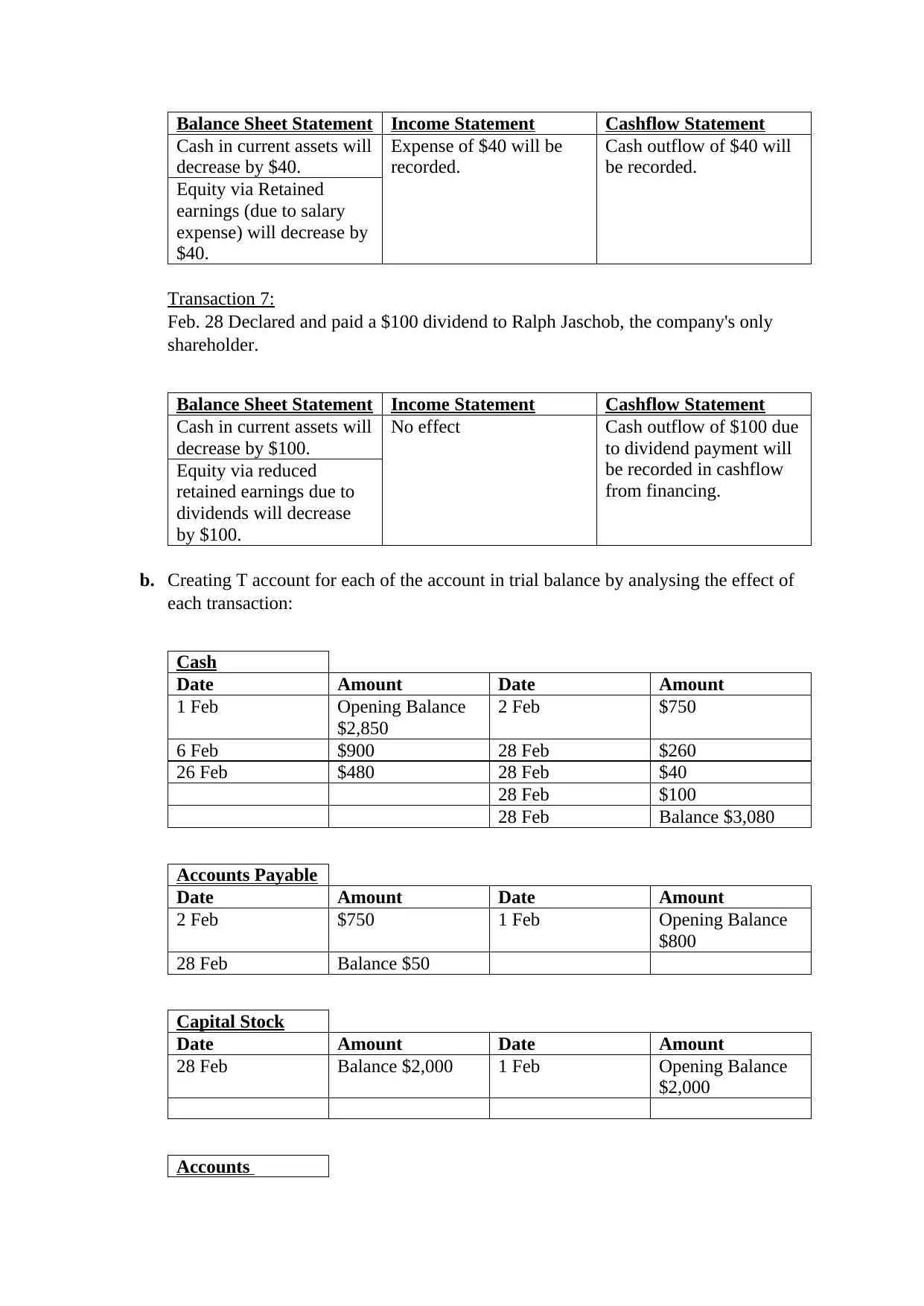
Balance Sheet Statement Income Statement Cashflow Statement
Cash in current assets will
decrease by $40.
Expense of $40 will be
recorded.
Cash outflow of $40 will
be recorded.
Equity via Retained
earnings (due to salary
expense) will decrease by
$40.
Transaction 7:
Feb. 28 Declared and paid a $100 dividend to Ralph Jaschob, the company's only
shareholder.
Balance Sheet Statement Income Statement Cashflow Statement
Cash in current assets will
decrease by $100.
No effect Cash outflow of $100 due
to dividend payment will
be recorded in cashflow
from financing.
Equity via reduced
retained earnings due to
dividends will decrease
by $100.
b. Creating T account for each of the account in trial balance by analysing the effect of
each transaction:
Cash
Date Amount Date Amount
1 Feb Opening Balance
$2,850
2 Feb $750
6 Feb $900 28 Feb $260
26 Feb $480 28 Feb $40
28 Feb $100
28 Feb Balance $3,080
Accounts Payable
Date Amount Date Amount
2 Feb $750 1 Feb Opening Balance
$800
28 Feb Balance $50
Capital Stock
Date Amount Date Amount
28 Feb Balance $2,000 1 Feb Opening Balance
$2,000
Accounts
Cash in current assets will
decrease by $40.
Expense of $40 will be
recorded.
Cash outflow of $40 will
be recorded.
Equity via Retained
earnings (due to salary
expense) will decrease by
$40.
Transaction 7:
Feb. 28 Declared and paid a $100 dividend to Ralph Jaschob, the company's only
shareholder.
Balance Sheet Statement Income Statement Cashflow Statement
Cash in current assets will
decrease by $100.
No effect Cash outflow of $100 due
to dividend payment will
be recorded in cashflow
from financing.
Equity via reduced
retained earnings due to
dividends will decrease
by $100.
b. Creating T account for each of the account in trial balance by analysing the effect of
each transaction:
Cash
Date Amount Date Amount
1 Feb Opening Balance
$2,850
2 Feb $750
6 Feb $900 28 Feb $260
26 Feb $480 28 Feb $40
28 Feb $100
28 Feb Balance $3,080
Accounts Payable
Date Amount Date Amount
2 Feb $750 1 Feb Opening Balance
$800
28 Feb Balance $50
Capital Stock
Date Amount Date Amount
28 Feb Balance $2,000 1 Feb Opening Balance
$2,000
Accounts
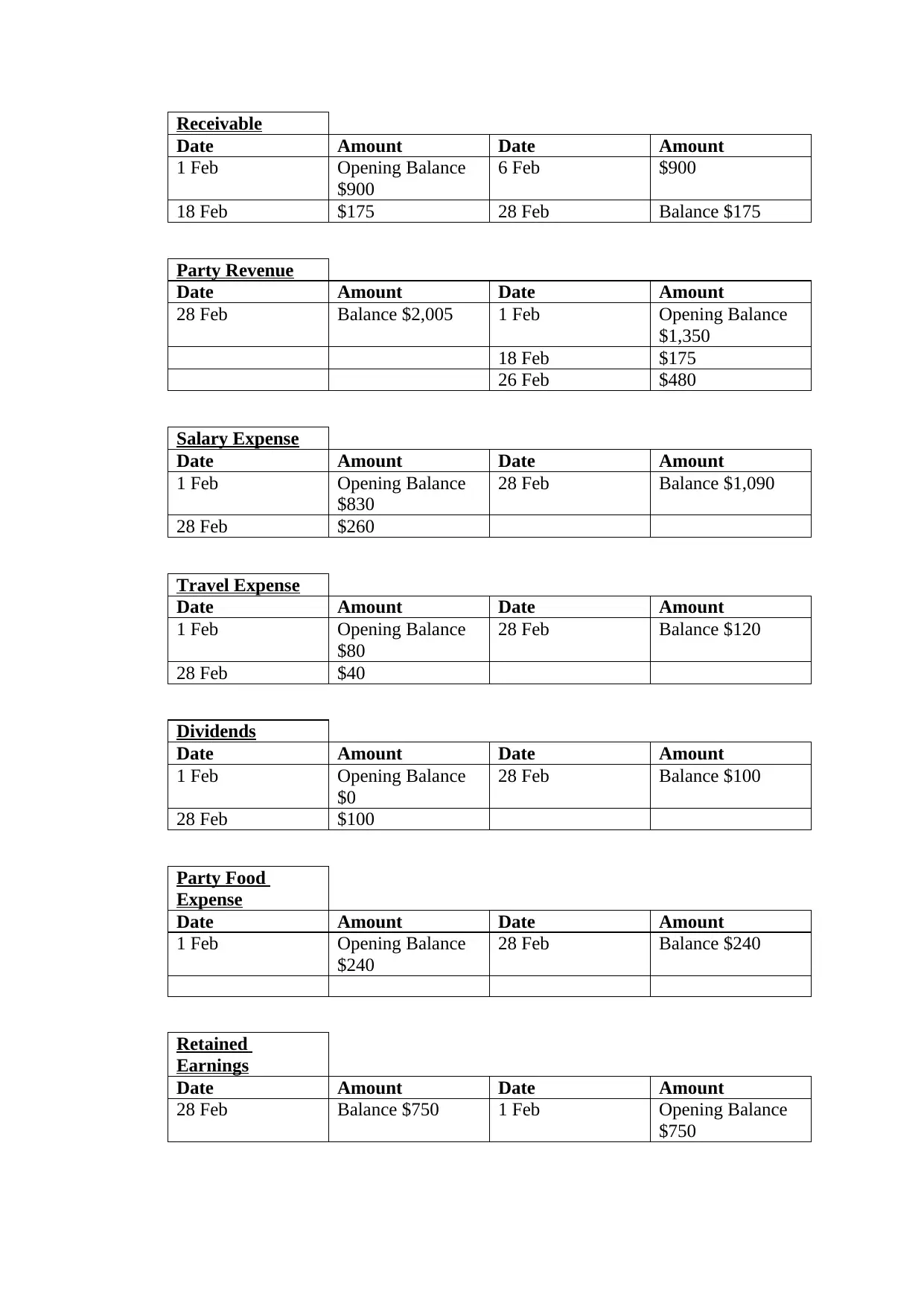
Receivable
Date Amount Date Amount
1 Feb Opening Balance
$900
6 Feb $900
18 Feb $175 28 Feb Balance $175
Party Revenue
Date Amount Date Amount
28 Feb Balance $2,005 1 Feb Opening Balance
$1,350
18 Feb $175
26 Feb $480
Salary Expense
Date Amount Date Amount
1 Feb Opening Balance
$830
28 Feb Balance $1,090
28 Feb $260
Travel Expense
Date Amount Date Amount
1 Feb Opening Balance
$80
28 Feb Balance $120
28 Feb $40
Dividends
Date Amount Date Amount
1 Feb Opening Balance
$0
28 Feb Balance $100
28 Feb $100
Party Food
Expense
Date Amount Date Amount
1 Feb Opening Balance
$240
28 Feb Balance $240
Retained
Earnings
Date Amount Date Amount
28 Feb Balance $750 1 Feb Opening Balance
$750
Date Amount Date Amount
1 Feb Opening Balance
$900
6 Feb $900
18 Feb $175 28 Feb Balance $175
Party Revenue
Date Amount Date Amount
28 Feb Balance $2,005 1 Feb Opening Balance
$1,350
18 Feb $175
26 Feb $480
Salary Expense
Date Amount Date Amount
1 Feb Opening Balance
$830
28 Feb Balance $1,090
28 Feb $260
Travel Expense
Date Amount Date Amount
1 Feb Opening Balance
$80
28 Feb Balance $120
28 Feb $40
Dividends
Date Amount Date Amount
1 Feb Opening Balance
$0
28 Feb Balance $100
28 Feb $100
Party Food
Expense
Date Amount Date Amount
1 Feb Opening Balance
$240
28 Feb Balance $240
Retained
Earnings
Date Amount Date Amount
28 Feb Balance $750 1 Feb Opening Balance
$750
⊘ This is a preview!⊘
Do you want full access?
Subscribe today to unlock all pages.

Trusted by 1+ million students worldwide
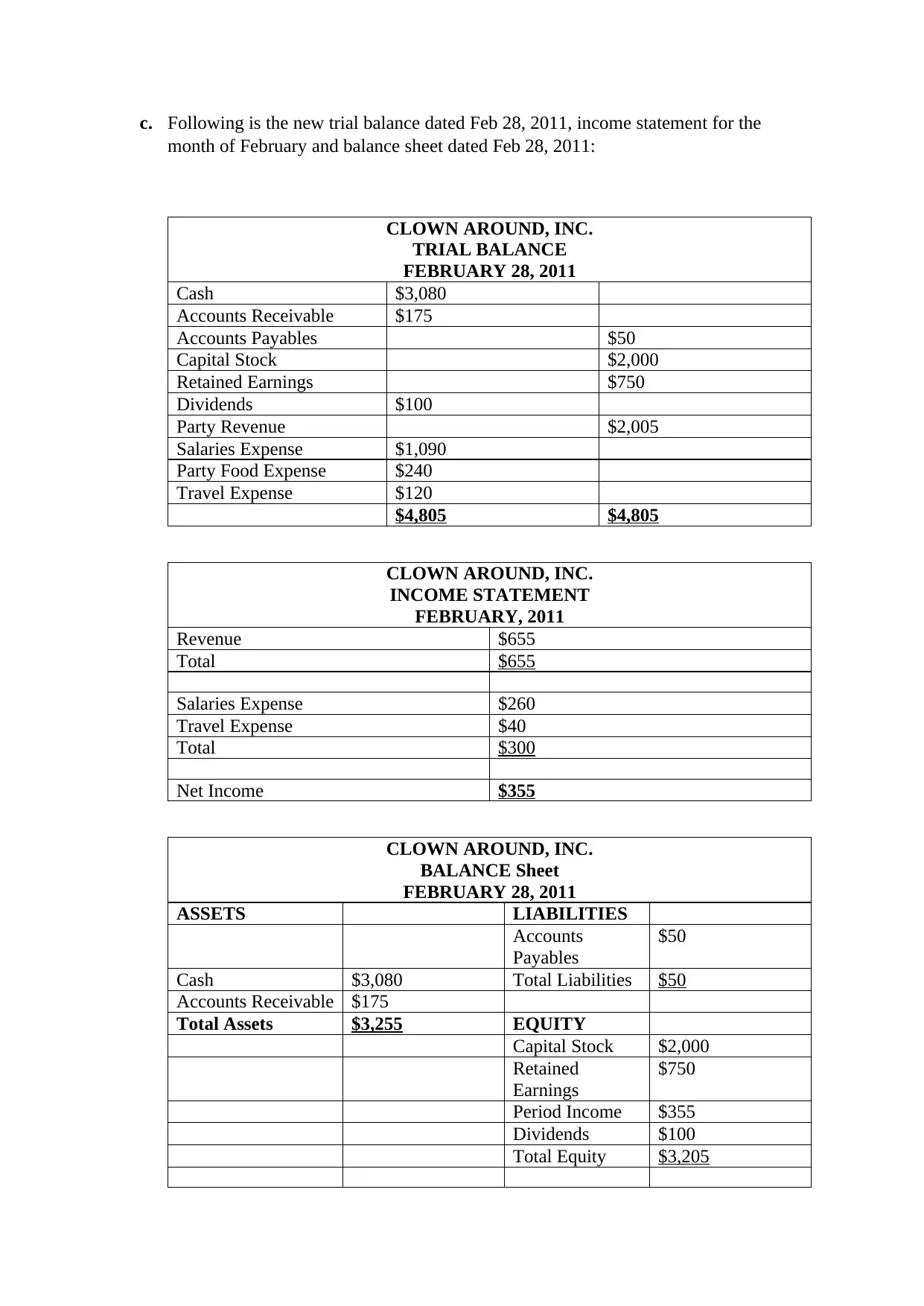
c. Following is the new trial balance dated Feb 28, 2011, income statement for the
month of February and balance sheet dated Feb 28, 2011:
CLOWN AROUND, INC.
TRIAL BALANCE
FEBRUARY 28, 2011
Cash $3,080
Accounts Receivable $175
Accounts Payables $50
Capital Stock $2,000
Retained Earnings $750
Dividends $100
Party Revenue $2,005
Salaries Expense $1,090
Party Food Expense $240
Travel Expense $120
$4,805 $4,805
CLOWN AROUND, INC.
INCOME STATEMENT
FEBRUARY, 2011
Revenue $655
Total $655
Salaries Expense $260
Travel Expense $40
Total $300
Net Income $355
CLOWN AROUND, INC.
BALANCE Sheet
FEBRUARY 28, 2011
ASSETS LIABILITIES
Accounts
Payables
$50
Cash $3,080 Total Liabilities $50
Accounts Receivable $175
Total Assets $3,255 EQUITY
Capital Stock $2,000
Retained
Earnings
$750
Period Income $355
Dividends $100
Total Equity $3,205
month of February and balance sheet dated Feb 28, 2011:
CLOWN AROUND, INC.
TRIAL BALANCE
FEBRUARY 28, 2011
Cash $3,080
Accounts Receivable $175
Accounts Payables $50
Capital Stock $2,000
Retained Earnings $750
Dividends $100
Party Revenue $2,005
Salaries Expense $1,090
Party Food Expense $240
Travel Expense $120
$4,805 $4,805
CLOWN AROUND, INC.
INCOME STATEMENT
FEBRUARY, 2011
Revenue $655
Total $655
Salaries Expense $260
Travel Expense $40
Total $300
Net Income $355
CLOWN AROUND, INC.
BALANCE Sheet
FEBRUARY 28, 2011
ASSETS LIABILITIES
Accounts
Payables
$50
Cash $3,080 Total Liabilities $50
Accounts Receivable $175
Total Assets $3,255 EQUITY
Capital Stock $2,000
Retained
Earnings
$750
Period Income $355
Dividends $100
Total Equity $3,205
Paraphrase This Document
Need a fresh take? Get an instant paraphrase of this document with our AI Paraphraser
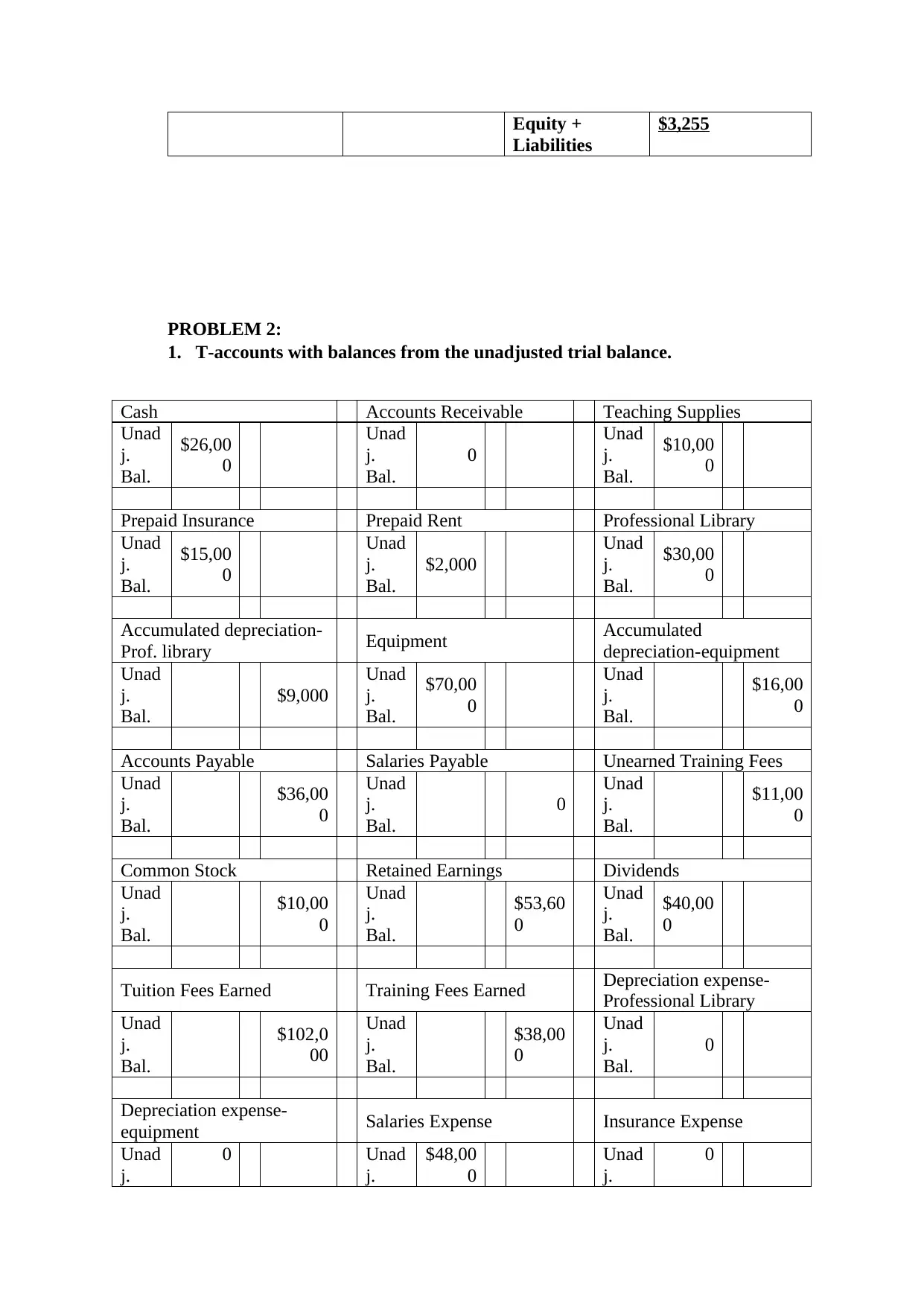
Equity +
Liabilities
$3,255
PROBLEM 2:
1. T-accounts with balances from the unadjusted trial balance.
Cash Accounts Receivable Teaching Supplies
Unad
j.
Bal.
$26,00
0
Unad
j.
Bal.
0
Unad
j.
Bal.
$10,00
0
Prepaid Insurance Prepaid Rent Professional Library
Unad
j.
Bal.
$15,00
0
Unad
j.
Bal.
$2,000
Unad
j.
Bal.
$30,00
0
Accumulated depreciation-
Prof. library Equipment Accumulated
depreciation-equipment
Unad
j.
Bal.
$9,000
Unad
j.
Bal.
$70,00
0
Unad
j.
Bal.
$16,00
0
Accounts Payable Salaries Payable Unearned Training Fees
Unad
j.
Bal.
$36,00
0
Unad
j.
Bal.
0
Unad
j.
Bal.
$11,00
0
Common Stock Retained Earnings Dividends
Unad
j.
Bal.
$10,00
0
Unad
j.
Bal.
$53,60
0
Unad
j.
Bal.
$40,00
0
Tuition Fees Earned Training Fees Earned Depreciation expense-
Professional Library
Unad
j.
Bal.
$102,0
00
Unad
j.
Bal.
$38,00
0
Unad
j.
Bal.
0
Depreciation expense-
equipment Salaries Expense Insurance Expense
Unad
j.
0 Unad
j.
$48,00
0
Unad
j.
0
Liabilities
$3,255
PROBLEM 2:
1. T-accounts with balances from the unadjusted trial balance.
Cash Accounts Receivable Teaching Supplies
Unad
j.
Bal.
$26,00
0
Unad
j.
Bal.
0
Unad
j.
Bal.
$10,00
0
Prepaid Insurance Prepaid Rent Professional Library
Unad
j.
Bal.
$15,00
0
Unad
j.
Bal.
$2,000
Unad
j.
Bal.
$30,00
0
Accumulated depreciation-
Prof. library Equipment Accumulated
depreciation-equipment
Unad
j.
Bal.
$9,000
Unad
j.
Bal.
$70,00
0
Unad
j.
Bal.
$16,00
0
Accounts Payable Salaries Payable Unearned Training Fees
Unad
j.
Bal.
$36,00
0
Unad
j.
Bal.
0
Unad
j.
Bal.
$11,00
0
Common Stock Retained Earnings Dividends
Unad
j.
Bal.
$10,00
0
Unad
j.
Bal.
$53,60
0
Unad
j.
Bal.
$40,00
0
Tuition Fees Earned Training Fees Earned Depreciation expense-
Professional Library
Unad
j.
Bal.
$102,0
00
Unad
j.
Bal.
$38,00
0
Unad
j.
Bal.
0
Depreciation expense-
equipment Salaries Expense Insurance Expense
Unad
j.
0 Unad
j.
$48,00
0
Unad
j.
0
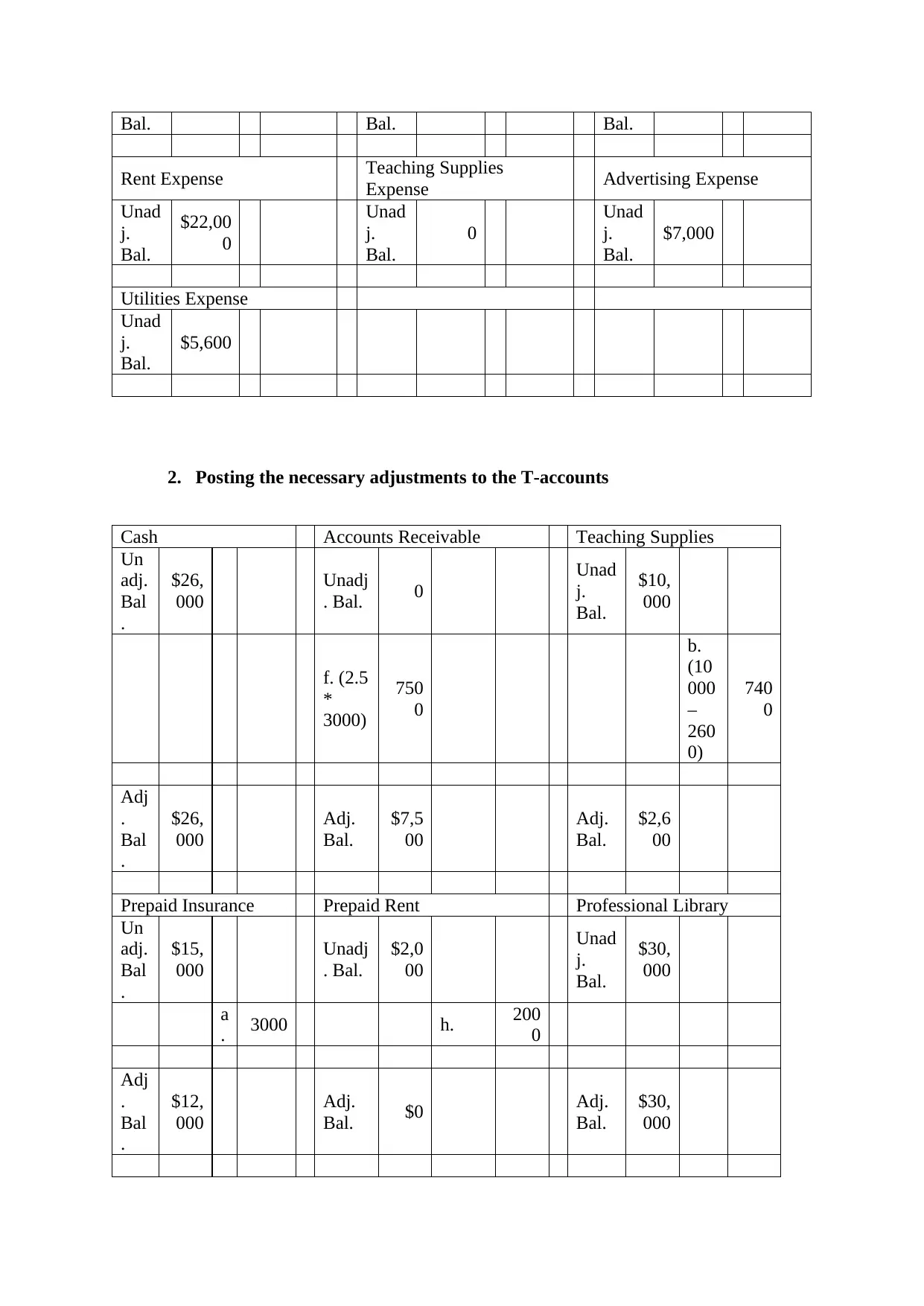
Bal. Bal. Bal.
Rent Expense Teaching Supplies
Expense Advertising Expense
Unad
j.
Bal.
$22,00
0
Unad
j.
Bal.
0
Unad
j.
Bal.
$7,000
Utilities Expense
Unad
j.
Bal.
$5,600
2. Posting the necessary adjustments to the T-accounts
Cash Accounts Receivable Teaching Supplies
Un
adj.
Bal
.
$26,
000
Unadj
. Bal. 0
Unad
j.
Bal.
$10,
000
f. (2.5
*
3000)
750
0
b.
(10
000
–
260
0)
740
0
Adj
.
Bal
.
$26,
000
Adj.
Bal.
$7,5
00
Adj.
Bal.
$2,6
00
Prepaid Insurance Prepaid Rent Professional Library
Un
adj.
Bal
.
$15,
000
Unadj
. Bal.
$2,0
00
Unad
j.
Bal.
$30,
000
a
. 3000 h. 200
0
Adj
.
Bal
.
$12,
000
Adj.
Bal. $0 Adj.
Bal.
$30,
000
Rent Expense Teaching Supplies
Expense Advertising Expense
Unad
j.
Bal.
$22,00
0
Unad
j.
Bal.
0
Unad
j.
Bal.
$7,000
Utilities Expense
Unad
j.
Bal.
$5,600
2. Posting the necessary adjustments to the T-accounts
Cash Accounts Receivable Teaching Supplies
Un
adj.
Bal
.
$26,
000
Unadj
. Bal. 0
Unad
j.
Bal.
$10,
000
f. (2.5
*
3000)
750
0
b.
(10
000
–
260
0)
740
0
Adj
.
Bal
.
$26,
000
Adj.
Bal.
$7,5
00
Adj.
Bal.
$2,6
00
Prepaid Insurance Prepaid Rent Professional Library
Un
adj.
Bal
.
$15,
000
Unadj
. Bal.
$2,0
00
Unad
j.
Bal.
$30,
000
a
. 3000 h. 200
0
Adj
.
Bal
.
$12,
000
Adj.
Bal. $0 Adj.
Bal.
$30,
000
⊘ This is a preview!⊘
Do you want full access?
Subscribe today to unlock all pages.

Trusted by 1+ million students worldwide
1 out of 18
Related Documents
Your All-in-One AI-Powered Toolkit for Academic Success.
+13062052269
info@desklib.com
Available 24*7 on WhatsApp / Email
![[object Object]](/_next/static/media/star-bottom.7253800d.svg)
Unlock your academic potential
Copyright © 2020–2025 A2Z Services. All Rights Reserved. Developed and managed by ZUCOL.





